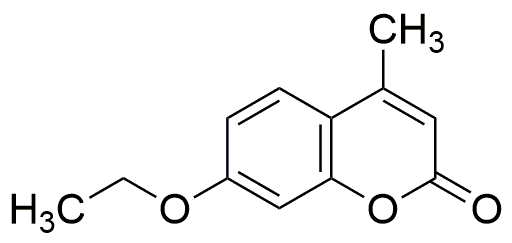7-Ethoxy-4-methylcoumarin is widely utilized in research focused on:
- Fluorescent Probes: This compound is often used in biological assays as a fluorescent probe due to its strong luminescence properties, making it ideal for tracking cellular processes in real-time.
- Photodynamic Therapy: In the medical field, it serves as a photosensitizer in photodynamic therapy, helping to treat certain types of cancer by generating reactive oxygen species upon light activation.
- Flavoring and Fragrance Industry: Its pleasant aroma makes it a popular choice in the formulation of perfumes and flavoring agents, providing a natural scent profile that enhances consumer products.
- Antioxidant Research: The compound is studied for its antioxidant properties, which can be beneficial in developing supplements aimed at reducing oxidative stress and improving health outcomes.
- Cosmetic Applications: It is incorporated into cosmetic formulations for its skin-conditioning benefits, helping to improve the texture and appearance of skin products.
General Information
Properties
Safety and Regulations
Applications
7-Ethoxy-4-methylcoumarin is widely utilized in research focused on:
- Fluorescent Probes: This compound is often used in biological assays as a fluorescent probe due to its strong luminescence properties, making it ideal for tracking cellular processes in real-time.
- Photodynamic Therapy: In the medical field, it serves as a photosensitizer in photodynamic therapy, helping to treat certain types of cancer by generating reactive oxygen species upon light activation.
- Flavoring and Fragrance Industry: Its pleasant aroma makes it a popular choice in the formulation of perfumes and flavoring agents, providing a natural scent profile that enhances consumer products.
- Antioxidant Research: The compound is studied for its antioxidant properties, which can be beneficial in developing supplements aimed at reducing oxidative stress and improving health outcomes.
- Cosmetic Applications: It is incorporated into cosmetic formulations for its skin-conditioning benefits, helping to improve the texture and appearance of skin products.
Documents
Safety Data Sheets (SDS)
The SDS provides comprehensive safety information on handling, storage, and disposal of the product.
Product Specification (PS)
The PS provides a comprehensive breakdown of the product’s properties, including chemical composition, physical state, purity, and storage requirements. It also details acceptable quality ranges and the product's intended applications.
Certificates of Analysis (COA)
Search for Certificates of Analysis (COA) by entering the products Lot Number. Lot and Batch Numbers can be found on a product’s label following the words ‘Lot’ or ‘Batch’.
*Catalog Number
*Lot Number
Certificates Of Origin (COO)
This COO confirms the country where the product was manufactured, and also details the materials and components used in it and whether it is derived from natural, synthetic, or other specific sources. This certificate may be required for customs, trade, and regulatory compliance.
*Catalog Number
*Lot Number
Safety Data Sheets (SDS)
The SDS provides comprehensive safety information on handling, storage, and disposal of the product.
DownloadProduct Specification (PS)
The PS provides a comprehensive breakdown of the product’s properties, including chemical composition, physical state, purity, and storage requirements. It also details acceptable quality ranges and the product's intended applications.
DownloadCertificates of Analysis (COA)
Search for Certificates of Analysis (COA) by entering the products Lot Number. Lot and Batch Numbers can be found on a product’s label following the words ‘Lot’ or ‘Batch’.
*Catalog Number
*Lot Number
Certificates Of Origin (COO)
This COO confirms the country where the product was manufactured, and also details the materials and components used in it and whether it is derived from natural, synthetic, or other specific sources. This certificate may be required for customs, trade, and regulatory compliance.


